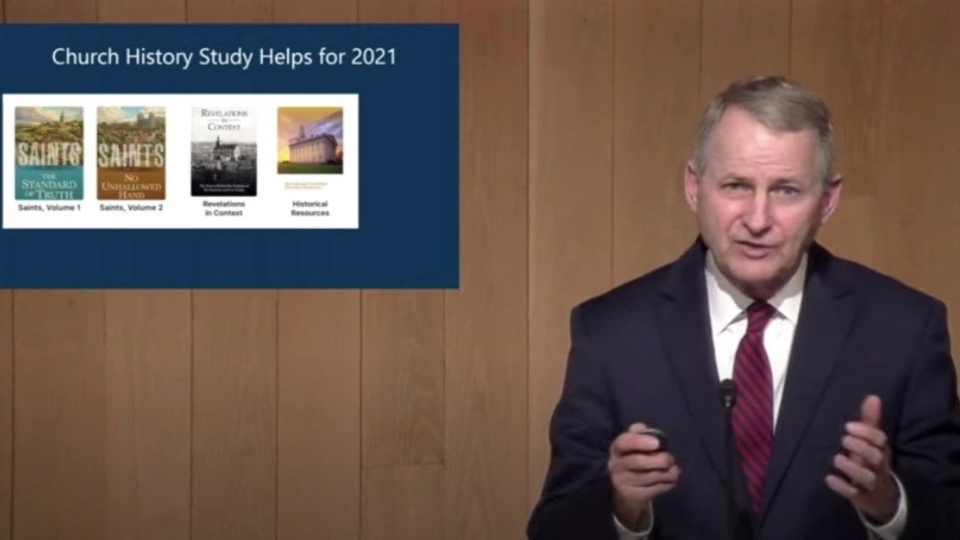
DC-Devo
Elder LeGrand R. Curtis Jr. speaks during an Evening from the Museum presentation streamed on Thursday, June 17, 2021. Screenshot courtesy of Church News.All rights reserved.This story appears here courtesy of TheChurchNews.com. It is not for use by other media.
By Christine Rappleye, Church News
One of Elder LeGrand R. Curtis Jr.’s many favorite lines in scripture is in Doctrine and Covenants 76.
The Prophet Joseph Smith and his family were living at the home of John and Elsa Johnson. Joseph was working on translation of the Bible when he and Sidney Rigdon had a vision. They would describe what they saw and confirm it with the other, including seeing Jesus Christ on the right hand of God and the celestial, terrestrial and telestial kingdoms.
The section also includes instructions on what they were supposed to write and share, along with warnings not to write about other things they saw. Those instructions continued with verse 116: “Neither is man capable to make them known, for they are only to be seen and understood by the power of the Holy Spirit, which God bestows on those who love him, and purify themselves before him” (Doctrine and Covenants 76:116).
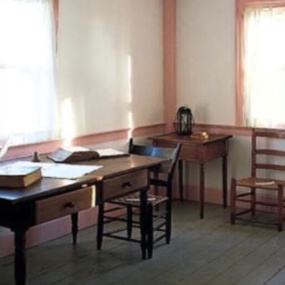
DC-Devo
The upstairs room in the Johnson Home in Hiram, Ohio, where Joseph Smith and Sidney Rigdon received the vision recorded in Doctrine and Covenants 76. Screenshot courtesy of Church News.All rights reserved.“I just love that description of the Holy Spirit and how God bestowed upon those who love and purify themselves before him,” Elder Curtis, the Church historian and recorder, executive director of the Church History Department and a General Authority Seventy, said during the Church History Museum’s Evenings from the Museum series on Thursday, June 17.
During the presentation, which was livestreamed on Facebook and YouTube, Elder Curtis highlighted several sections that have had an impact on him, along with the history of publishing the Doctrine and Covenants and study materials from the Church History Department. The Doctrine and Covenants includes a series of revelations given to Joseph Smith and other latter-day prophets, and it’s the focus of this year’s Come, Follow Me study in Sunday School classes of The Church of Jesus Christ of Latter-day Saints.
“I think one of the interesting ways to think about the Doctrine and Covenants is to think about some of the great sections in there and the impact that they have on our doctrine, the impact they have on our history and, most importantly, the impact they have had on us personally — spiritual experiences that we have had,” he said.
In lieu of asking the audience for sections that have impacted their lives, he nominated many sections that have affected his life, including Section 76, as his family visited the Johnson Home and saw the upstairs room, and also the Lord’s preface in Section 1.
“It’s the Lord speaking to the people of this dispensation and telling us to hearken and telling us to pay attention to these revelations that are in this book because they’re true,” Elder Curtis said. “And I think, very significantly, He says he called upon Joseph Smith and others. It is, in a sense, the Lord’s testimony of the calling of the Prophet Joseph Smith.”
Other sections he mentioned include:
- Doctrine and Covenants 4, about missionary work, which he memorized two different versions of in Italian due to translation changes between the times he served in Italy
- Doctrine and Covenants 19, where Jesus Christ describes His own suffering in Gethsemane
- Doctrine and Covenants 21 about the organization of the Church
- Doctrine and Covenants 25 about Emma Smith and her calling to help support Joseph
- Doctrine and Covenants 109–110 about the Kirtland Temple dedication and the temple being accepted
- Doctrine and Covenants 121–123, which were received in Liberty Jail
- Official Declaration 2, which removed all restrictions with regard to race that once applied to the priesthood
He also outlined 18 more sections and noted there were many more that could be listed.
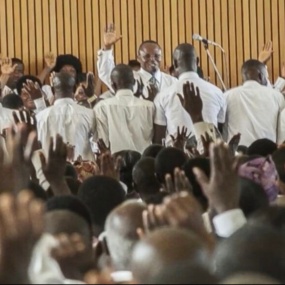
DC-Devo
This photo from Elder LeGrand R. Curtis Jr. shows a stake conference in Ghana where men are being presented to receive the Melchizedek Priesthood. Elder Curtis shared the photo during an Evening from the Museum presentation streamed on Thursday, June 17, 2021. Screenshot courtesy of Church News.All rights reserved.Elder Curtis, who spent five years on assignment in West Africa, shared a photo of a conference in Ghana where dozens of men stood shoulder to shoulder with others, raising hands to sustain them. The names of the men who were standing had just been presented by the stake president to receive the Melchizedek Priesthood.
“I don’t have words to describe what it means to me to have my African and other Black brethren have the priesthood of God, and to have watched what they did and to stand in the circle with them as they give blessings and settings apart,” Elder Curtis said. “It is one of the great events of this dispensation that in 1978 Spencer W. Kimball received the revelation with respect to the priesthood.”
Elder Curtis shared his gratitude for the Doctrine and Covenants.
“If all we had was section 76 or 93 or 19 or on and on, it would be such a treasure for us,” he said. “But to have a whole book of them and to have the history that goes behind it, and to have the faith of those who lived that history going before us as an example, I think, is a marvelous thing.”
Study Helps
“The book of the Doctrine and Covenants is unique among the various scriptures of the church,” Elder Curtis said. “It contains revelations, including visions, and [there are] letters, minutes, a dedicatory prayer and a translation.”
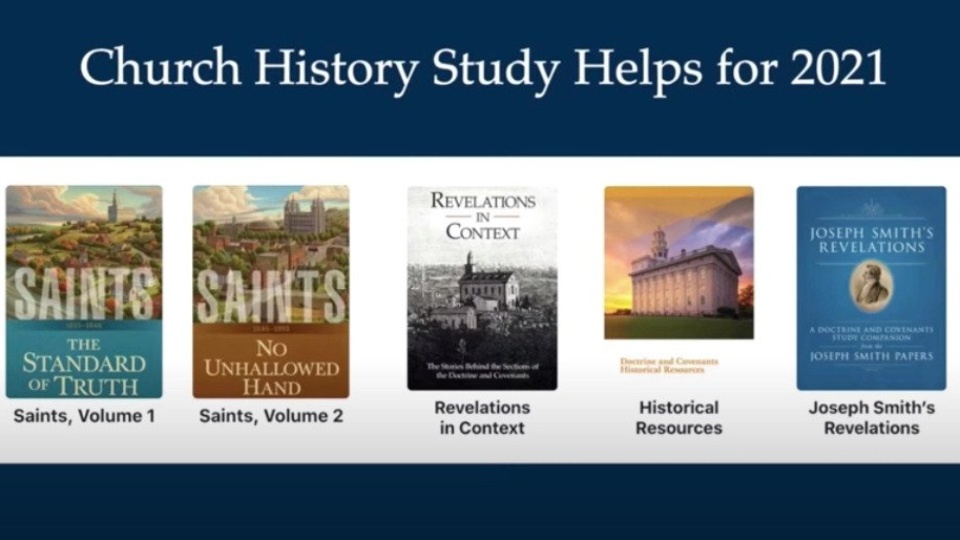
DC-Devo
Elder LeGrand R. Curtis Jr. noted these study helps for the Doctrine and Covenants during an Evening from the Museum presentation streamed on Thursday, June 17, 2021. Screenshot courtesy of Church News.All rights reserved.Elder Curtis pointed out resources from the Church History Department to help in studying the Doctrine and Covenants.
- Saints: Volume 1, The Standard of Truth, 1815–1846 and Saints: Volume 2, No Unhallowed Hand, 1846–1893 share the history of the Church in a narrative format. “One of the real valuable things about being able to read Saints, Volume 1 is you get the run of the story and then see how revelations fit into it,” Elder Curtis said.
- Revelations in Context consists of essays with the circumstances of the revelations in the Doctrine and Covenants. Elder Curtis said he recently finished reading the Doctrine and Covenants and used Revelations in Context as he studied. “It’s just a wonderful experience to see how that expands your vision,” he said. “And you understand better why the Lord is saying the things He’s saying once you see what the Saints were undergoing at that time.”
- Historical Resources is a compilation of information from The Joseph Smith Papers, short biographies of the people mentioned, background from Revelations in Context, relevant Church History Topics essays, and places and chronology for each Come, Follow Me lesson.
- Joseph Smith’s Revelations has information from The Joseph Smith Papers for each section.
These resources are in the Gospel Library app and online under “Restoration and Church History.”
Publishing the Doctrine and Covenants
The revelations were written on loose sheets of papers, then put in journal-style books, Elder Curtis said. Several of the revelations were also initially printed in the Church’s newspapers, such as The Evening and the Morning Star, to help distribute them.
In the summer of 1833, W.W. Phelps was nearly finished printing the Book of Commandments on a press in Independence, Missouri, when the building was attacked by a mob. The mob pulled the press out of the second floor and tore down the building, he said. This is when Caroline and Mary Elizabeth Rollins saved printed pages from the book. Others also picked up pages, he said.
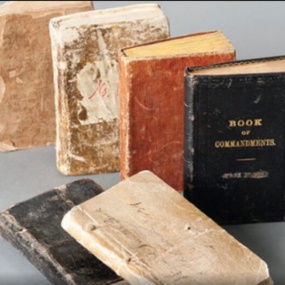
DC-Devo
These copies of the Book of Commandments are all bound in different ways, Elder LeGrand R. Curtis Jr. noted during an Evening from the Museum presentation streamed on Thursday, June 17, 2021. Screenshot courtesy of Church News.All rights reserved.From those saved pages came the Book of Commandments. There were 64 and a half printed revelations. The unbound chapters sold for 25 cents, and the owners had to decide how to bind them together.
Wilford Woodruff wrote the second half of chapter 65 in his copy, Elder Curtis said.
In 1835, the Doctrine and Covenants was printed on a press in Kirtland, Ohio. The first part of the book was the seven Lectures on Faith, and the second part had 103 revelations, including the 65 from the Book of Commandments, and the appendix, which is now section 133, he said.
“A new name emerged for the book: ‘Doctrine,’ which was the part that was the lectures, and ‘Covenants,’ which were the 103 revelations,” he said.
Another edition was published in 1844 in Nauvoo, Illinois, and leaders were able to work in a tribute to Joseph and Hyrum Smith at the end as section 111, now known as section 135. It was in a smaller font to fit in the available space, Elder Curtis said.
In 1876 the Saints were in Utah, and Orson Pratt, then the Church historian, added 26 sections, including sections 2, 13, 109, 110, 121–123, 132 and 136. He also arranged the sections in approximate chronological order, made the verses shorter and changed the section headings.
I think it’s remarkable the treasures he pulled out of the Church history records and put into the Doctrine and Covenants,” Elder Curtis said.
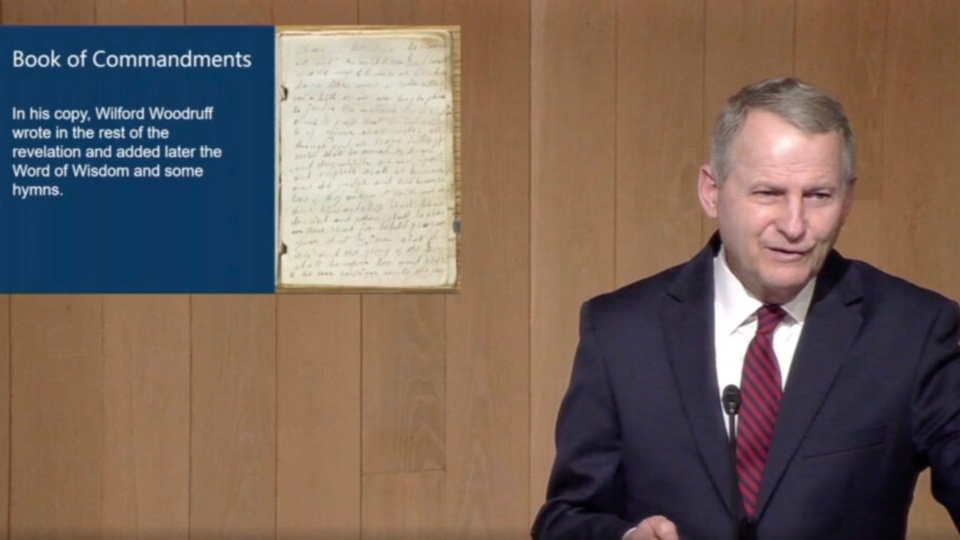
DC-Devo
Elder LeGrand R. Curtis Jr. speaks during an Evening from the Museum presentation streamed on Thursday, June 17, 2021. Screenshot courtesy of Church News.All rights reserved.For the 1921 edition, a committee of five apostles was formed to review the Doctrine and Covenants. Their changes included adding the manifesto from President Wilford Woodruff as an official declaration and removing the Lectures on Faith, Elder Curtis said.
In the 1981 edition, Joseph Smith’s 1836 vision of the celestial kingdom and Joseph F. Smith’s 1918 vision of the redemption of the dead were added as sections 137 and 138. Both had previously been published in the Pearl of Great Price.
“I remember having little paper copies that they sold that I taped into my copy of the triple combination,” he said.
Also, the 1978 revelation on priesthood was added as an official declaration, and footnotes were added to correspond with the Latter-day Saint edition of the King James Bible that was published in 1979.
The 2013 edition includes updated section headings based on research through the Joseph Smith Papers Project and historical introductions to the official declarations.
Copyright 2021 Deseret News Publishing Company